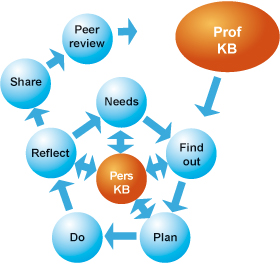Use 'Print preview' to check the number of pages and printer settings.
Print functionality varies between browsers.
Printable page generated Sunday, 23 November 2025, 6:48 AM
V09s: Blogging: beyond social networking
Course information

You will need access to:
- a computer with a web browser
- a class/group of students – groups could be within classes, whole classes or groups across classes (e.g. clubs) and schools (e.g. collaborative projects across schools).
Duration of the course: 6 hours (including a 2 hour face-to-face session with a facilitator) over six weeks.
- Online total: 3 hours
- Offline total: 3 hours
- face-to-face: 2 hours with a facilitator
- workplace: 1 hour (creating a simple blog for personal or classroom use)
Learning outcomes
Professional and reflective practitioner skills
At the completion of this course, you should be able to:
- identify opportunities for groups of learners to contribute their ideas to a learning activity through the use of a classroom blog
- understand how to support learners to make appropriate contributions through the development with them of a suitable code of conduct for the class blog.
Practical skills
At the completion of this course, you should be able to:
- find out whether there are opportunities to create a class blog on your local VLE
- create a personal or class blog.
Knowledge and understanding
At the completion of this course, you should be able to demonstrate:
- that you recognise how particular learning activities may be enhanced by student contributions and shared ideas through blogging
- that a code of conduct and examples of appropriate contributions can be used to support learners to make appropriate and meaningful contributions to a class blog.
Cognitive skills
At the completion of this course, you should be able to:
- evaluate the value of blogging as a way of encouraging students to make contributions to a learning activity
- discuss the use of blogs in different learning activities as a way of encouraging learners to contribute their ideas and knowledge.
Course schedule
| Week | Activities | Type | Duration |
| 1 | Activity 1 Pre-course activity – an example of a resource sharing blog | Online | 30 minutes |
| Activity 2 Pre-course activity – an example of a school’s MFL blog | Online | 30 minutes | |
| 2 | Facilitated session | Face to face | 2 hours |
| 3 – 5 | Activity 3 Post-course activity – reflecting on the course so far by posting in the forum | Online | 30 minutes |
| 3 | Activity 4 Post-course activity – creating your own blog for personal or classroom use | Workplace | 1 hour |
| 6 | Activity 5 Extracting our shared learning | Online | 30 minutes |
| Activity 6 Feedback and evaluation | Online | 1 hour | |
| Total 6 hours |
Introduction

This course introduces the use of blogs in classroom learning activities to support learners to make contributions, and share knowledge and ideas. Blogging software will be demonstrated with ideas for the type of learning activity that blogging can support. You will have opportunity to view existing blogs and assess their value in sharing resources or encouraging contributions.
The reflective cycle
Vital courses are based on a cycle of professional reflective practice as shown in the diagram below.

This cycle draws on, and develops, personal and professional knowledge bases. The latter may be seen in the literature, resources, policies and other materials that are used to inform practice.
Throughout the course small icons will indicate the stage of the cycle being addressed.
NB Prof/Pers KB = Professional/Personal knowledge base.
Pre-course activity

Pre-course activities will introduce you to the world of blogging and why it is seen to be useful in supporting learners to make contributions and share their ideas and knowledge when working on suitable learning tasks. The activities will be addressed by the course facilitator at the beginning of the face-to-face session.
 Activity 1 An example of a resource sharing blog
Activity 1 An example of a resource sharing blog
The objectives of this course activity are to:
- examine a blog written to demonstrate and share resources with teachers
- browse the resources and identify any that might be useful to you in your teaching.
Go to The Free Technology for Teachers website where you will find a blog that has been written by Richard Byrne, an American teacher. He has created this blog to provide up to date information about open source software that may have value in the classroom. Several Google tools feature in his overview. This blog is award-winning – it won the Best Resource Sharing category in the 2008 and 2009 Edublogs Awards. Blogging is an effective way of resource sharing, as this example demonstrates. Explore this blog and follow any links that might be of interest to you. Reflect on whether you could see the value of creating a resource sharing blog for your learners, or even for the wider school or college you work in. Creating a blog that is linked to a classroom project where learners could add resources or links they have come across might be one way in which learners are encouraged to contribute. Make note of any ideas you might have for a resource sharing blog.
 Activity 2 An example of a school’s Modern Foreign Languages blog
Activity 2 An example of a school’s Modern Foreign Languages blog
The objectives of this course activity are to:
- see an example of a school’s blog dedicated to Modern Foreign Languages
- see the different content that can be uploaded and added to a blog and reflect on whether this type of blog could be useful in your classroom.
Go to this UK secondary school blog All Saints Languages Blog which has been created by teacher Suzi Bewell. This is a subject-specific blog that has been created using Typepad blogging software (you will be shown this software in the face to face session). This blog uses a wide variety of media, including video, examples of students’ work and useful links to other resources. Browse the blog and reflect on the way this is presented, the type of content featured and the many links, gadgets and widgets used on the site. Make notes as you browse thinking about whether your learners could contribute to a similar blogging space, what topic you might focus on and what resources or links you may already know of that could be included.
The face-to-face session
You will have received information about the venue and time of the face-to-face component of this course. You will have 2 hours with a facilitator and other participants during which you will be shown examples of blogging software (including Blogger, Typepad and WordPress) and given some ideas of how these spaces can be created and shared with learners. A course forum will open when this session is completed where you will be able to share ideas with fellow participants and reflect more upon the follow up to this session.
Following the face-to-face session

The post-course activities will build on the content covered in the face-to-face session and give you an opportunity to post messages to other course participants in the course forum.
 Activity 3 Reflecting on the course so far by posting in the forum
Activity 3 Reflecting on the course so far by posting in the forum
The objectives of this course activity are to:
- make contact with participants of the face-to-face session
- share ideas emerging from the course so far.
The course forum is available to all participants of the course after the end of the two hour facilitated session. Go to the forum and post a message to the other participants. Reflect on the course so far, or post some ideas that have emerged from your experience of seeing blog examples and thinking about what sort of blog you might create for your learners. If you have found any good examples of blogs that others on the course might find interesting, you can include the URL in a message.
 Activity 4 Creating your own blog for personal or classroom use
Activity 4 Creating your own blog for personal or classroom use
The objective of this course activity is to use one of the demonstrated blogging software providers to create your own blog for personal use or for use with your learners.
You will have seen examples of blogging software that is freely available for your use at the face-to-face session. Choose one of these and create your own blog. You may want to create your own personal blog as a trial, rather than focus on something that learners can contribute to. Or you may have plans for an activity in your existing scheme of work that could include a blog as an additional resource. You will be able to continue to build on your blog after the course, but for the purpose of completion of the course, create a simple blog, add text or images or links and visit the forum to post a message about your experiences using your chosen software. Share the URL for your blog with your fellow forum participants and ask for feedback.
Shared learning

The reflective practitioner cycle is based on developing the professional knowledge base. We have now come to the end of the personal reflection phase and are to develop a common understanding of what we have learnt. We will share the key learning points as a group so that these may be collated and added to the community knowledge.
 Activity 5 Extracting our shared learning
Activity 5 Extracting our shared learning
The objectives of this course activity are to discuss and agree what we have learnt as a group.
Go to the course forum and, in the Discussion called ‘Shared Learning’, post the key learning points that have emerged for you during the course. With your facilitator, agree on the common shared learning from the group.
This might include feelings about the potential uses of blogging for you or your learners, examples that you have found of good, or bad, blogging sites, and ideas on how you might move forward with your newly found blogging skills.
Evaluation and certification
This final section allows for evaluation and certification.
 Activity 6 Feedback and certification
Activity 6 Feedback and certification
The objectives of this course activity are to complete an evaluation form and, if you wish, print a course completion certificate and rate and review the course.
Your task is to complete the evaluation questionnaire, which can be found on the course page. There are also links there to print a certificate and rate the course. The certificate will be ‘released’ by your facilitator.
References
- Bewell, S., All Saints Languages Blog http://allsaintslanguagesblog.typepad.co.uk/ all_saints_languages_blog Accessed 31 August 2011.
- Byrne, R., Free Technology for Teachers http://www.freetech4teachers.com Accessed 31 August 2011.